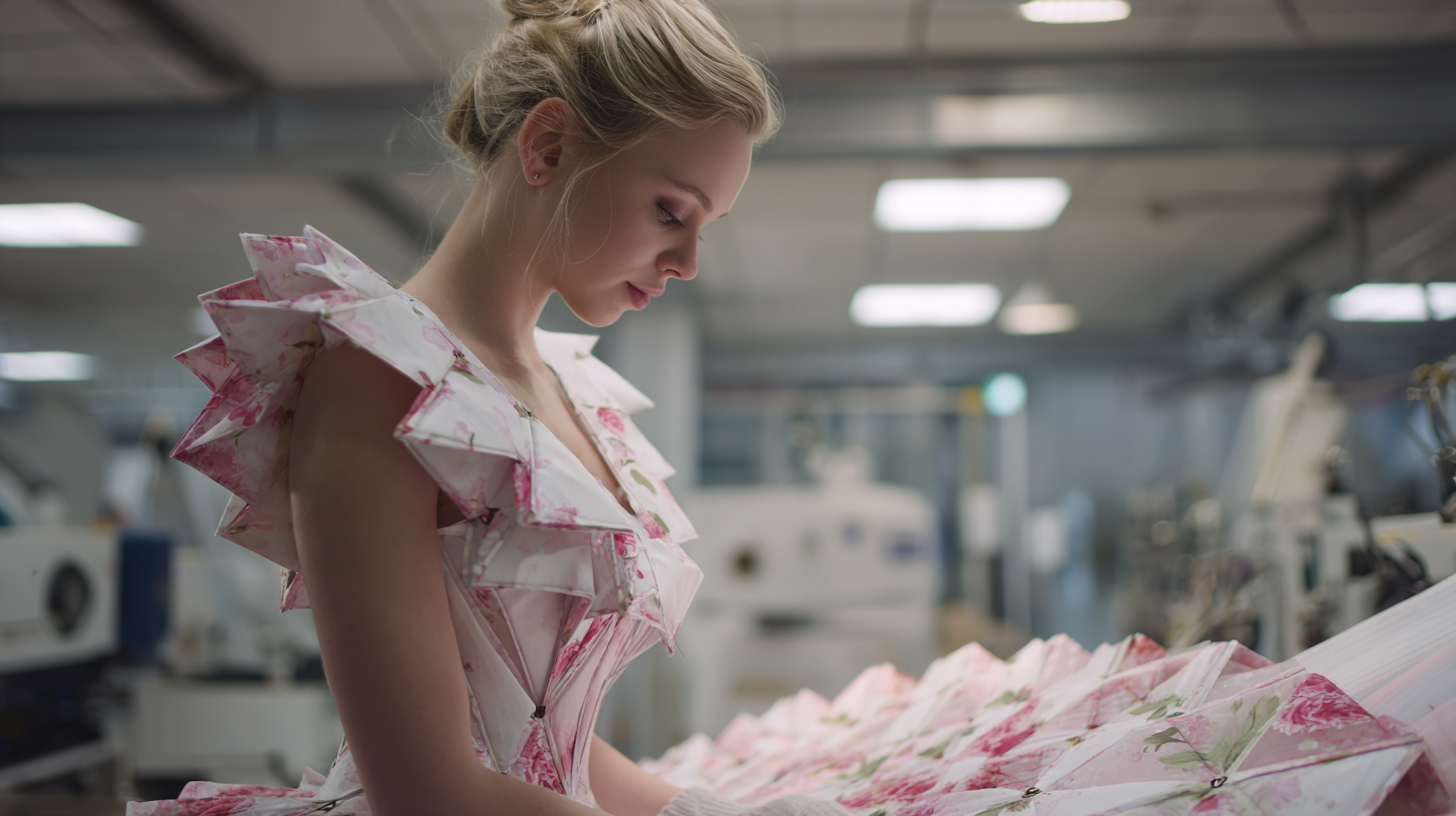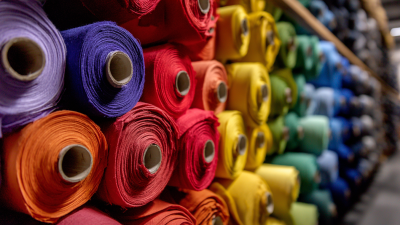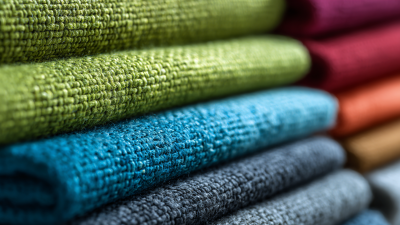 As the fashion industry increasingly confronts the pressing challenges of sustainability and environmental impact, the transformation of waste materials into usable products has gained significant momentum. Among the innovative solutions, Recycled PET Fabric stands out, as it capitalizes on the reuse of post-consumer plastic bottles. According to a report by the Textile Exchange, approximately 30% of global fiber production is now derived from recycled sources, with recycled polyester taking the lead due to its lower environmental footprint. The Global Recycling Foundation highlights that every ton of recycled PET fabric can save more than 7,500 gallons of water and reduce energy consumption by up to 80% compared to virgin polyester production. This shift not only contributes to a circular economy but also inspires the fashion sector to adopt eco-friendly practices, paving the way for a greener future while appealing to environmentally conscious consumers.
As the fashion industry increasingly confronts the pressing challenges of sustainability and environmental impact, the transformation of waste materials into usable products has gained significant momentum. Among the innovative solutions, Recycled PET Fabric stands out, as it capitalizes on the reuse of post-consumer plastic bottles. According to a report by the Textile Exchange, approximately 30% of global fiber production is now derived from recycled sources, with recycled polyester taking the lead due to its lower environmental footprint. The Global Recycling Foundation highlights that every ton of recycled PET fabric can save more than 7,500 gallons of water and reduce energy consumption by up to 80% compared to virgin polyester production. This shift not only contributes to a circular economy but also inspires the fashion sector to adopt eco-friendly practices, paving the way for a greener future while appealing to environmentally conscious consumers.
Recycling polyethylene terephthalate (PET) is a pivotal process in addressing environmental concerns linked to plastic waste. PET, commonly found in beverage bottles, is one of the most recycled plastics globally. The recycling process begins with the collection and sorting of used bottles, followed by cleaning and shredding. This results in clean flakes which can be melted down and reformed into various products, including fibers for textiles. The transformation of discarded bottles into fabric not only reduces landfill waste but also conserves energy and raw materials compared to virgin production.
The environmental impact of PET recycling is significant. By recycling PET, we can drastically reduce greenhouse gas emissions—up to 75% less compared to producing new PET from petroleum. Moreover, the recycling process helps in decreasing the dependency on fossil fuels, which are finite resources. Additionally, using recycled PET in the fashion industry promotes the notion of circular economies, where materials are reused and repurposed rather than discarded. This not only supports sustainable practices in fashion but also raises awareness about the importance of recycling in mitigating pollution and promoting a cleaner planet.
This chart illustrates the annual data for the year 2022, showcasing the millions of tons of plastic bottles recycled, the amount of recycled PET fabric produced, and the corresponding energy savings. These figures highlight the significant environmental impact of recycling PET materials into fashionable fabrics.
 The journey of transforming PET bottles into fashionable recycled fabrics begins with an essential step: the collection and sorting process. With a global PET bottle recycling market projected to reach $4.23 billion in 2024 and grow to $6.32 billion by 2033 at a CAGR of 4.2%, the importance of efficient collection and sorting methods cannot be overstated. Companies are implementing innovative strategies to gather used PET bottles, ensuring that they are processed correctly to create high-quality recycled materials.
The journey of transforming PET bottles into fashionable recycled fabrics begins with an essential step: the collection and sorting process. With a global PET bottle recycling market projected to reach $4.23 billion in 2024 and grow to $6.32 billion by 2033 at a CAGR of 4.2%, the importance of efficient collection and sorting methods cannot be overstated. Companies are implementing innovative strategies to gather used PET bottles, ensuring that they are processed correctly to create high-quality recycled materials.
Tips: To enhance recycling efforts, individuals can participate in local recycling programs and stay informed about proper recycling practices. Sorting materials at home before disposal can significantly improve the efficiency of the recycling process. Additionally, businesses can collaborate with recycling firms to streamline their waste management systems.
As the industry faces challenges, such as misleading claims from beverage companies regarding recyclability, it becomes crucial for consumers to understand the intricacies of recycling. By being vigilant about the products they choose, consumers can contribute to a more sustainable future, ensuring that the evening out the carbon footprint associated with plastic production becomes a shared responsibility. Engaging in the conversation about recycling and supporting brands that prioritize eco-friendly practices can lead to significant change.
Recycling PET bottles into sustainable fabric involves an innovative and meticulous process. Firstly, collected bottles are sorted, cleaned, and crushed into small flakes. These flakes are then melted down and transformed into PET pellets, which serve as the raw material for fabric production. The next step involves spinning the pellets into fibers, which can be woven or knitted into high-quality textile materials. This eco-friendly approach not only reduces plastic waste but also lowers the need for virgin materials, contributing to a circular economy.
Tips for Sustainable Fashion Choices: When purchasing clothing made from recycled fabrics, look for certifications indicating sustainable practices. Moreover, consider the longevity of such items; investing in quality pieces can ward off frequent replacements and decrease overall waste. Lastly, support brands that are transparent about their sourcing and manufacturing processes, as this promotes a more responsible fashion industry. By aligning with these practices, consumers can play an integral role in fostering sustainability.
As the final step, the finished fabrics are dyed and processed into stylish clothing. This transformation showcases how consumer goods can be revitalized into fashion, turning waste into a valuable resource. Adopting recycled PET fabric not only helps in the reduction of plastic pollution but also promotes an eco-conscious lifestyle that resonates in today’s fashion industry.
In recent years, the fashion industry has adopted innovative applications of recycled PET fabric, transforming how we perceive sustainability. Recycled PET, derived from used plastic bottles, is not only eco-friendly but also versatile. Designers are creatively utilizing this material in various fashions, from trendy activewear to stylish evening gowns. The lightweight and moisture-wicking properties of recycled PET make it particularly suitable for sports apparel, providing both comfort and performance for active individuals.
Tips: When shopping for sustainable fashion, look for labels that specify the use of recycled materials. This not only supports eco-conscious brands but also encourages more designers to explore sustainable options. Additionally, consider the lifecycle of your clothing and opt for versatile pieces that can be worn in multiple settings.
Recycled PET fabric is making waves beyond typical clothing items. Accessories like bags, hats, and shoes are now crafted from this sustainable material, enhancing their appeal while reducing waste. Some innovative brands are also experimenting with textures and patterns, making recycled PET fabrics not just eco-friendly but desirable in terms of aesthetic value. This shift towards sustainability demonstrates that fashion can be both trendy and responsible, paving the way for a greener future in the industry.
| Key Dimension | Description | Impact |
|---|---|---|
| Feedstock | Recycled PET from plastic bottles | Reduces waste in landfills |
| Production Process | Mechanical recycling and fiber production | Low energy consumption compared to virgin fiber |
| Applications | Apparel, accessories, and home textiles | Promotes sustainability in fashion industry |
| Durability | High durability and moisture-wicking properties | Enhances product lifespan |
| Market Trends | Increasing demand for eco-friendly fabrics | Supports circular economy initiatives |
In the wake of environmental concerns, the fashion industry is making strides towards sustainable practices by incorporating recycled materials, particularly PET fabric derived from plastic bottles. This transformation not only reduces waste but also promotes eco-conscious consumerism. As the journey from discarded bottles to fashionable garments continues, consumers can play a crucial role in supporting this initiative by choosing recycled fashion items.

When selecting recycled fashion, look for brands that are transparent about their sourcing and production processes. Many companies proudly display their commitment to sustainability, providing details on how they source recycled materials and the impact of their practices on the environment. Additionally, aim for items that feature a higher percentage of recycled content—this often indicates a stronger commitment to sustainability.
Another tip is to explore second-hand or upcycled fashion, which provides a unique opportunity to discover one-of-a-kind pieces while further minimizing waste. Thrift stores and online platforms focusing on pre-owned clothing are great places to find stylish options that not only set you apart but also contribute to a circular economy. By making informed choices, you can confidently embrace fashion that aligns with your values and supports the planet.






